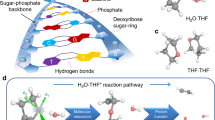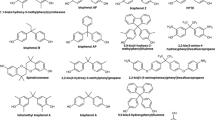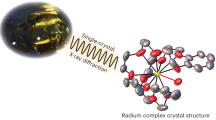Abstract
ONE of the major problems encountered in using the heavy atom X-ray method1 to determine the structure of steroids2,3 (or any other molecule) is the possibility that the direct attachment of a heavy atom to the molecule will cause distortion. Theoretically, the amount of distortion is determined by steric factors and the stability of the electronic configurations adjacent to the site of attachment. For example, when a bromine atom is covalently attached to carbon four of an aromatic A-ring of the steroid nucleus, it is reasonable to expect that the resulting distortion would be insignificant, because of the stability imparted to the A-ring by the aromatic system. Experimental evidence supporting this expectation was obtained in the molecular-structure determinations of 4-bromoestrone2 and 4-bromoestradiol3. In these brominated steroids, the A-rings are extremely planar (non-planarity coefficients 0.02 Å in both cases) despite the covalently attached bromine.
This is a preview of subscription content, access via your institution
Access options
Subscribe to this journal
Receive 51 print issues and online access
$199.00 per year
only $3.90 per issue
Buy this article
- Purchase on Springer Link
- Instant access to full article PDF
Prices may be subject to local taxes which are calculated during checkout
Similar content being viewed by others
References
Robertson, J. M., Organic Crystals and Molecules, chap. 6 (Cornell University Press, Ithaca, 1953).
Norton, D. A., Kartha, G., and Lu, C. T., Acta Cryst., 17, 77 (1964).
Norton, D. A., Kartha, G., and Lu, C. T., Acta Cryst., 16, 89 (1964).
Collins, D. J., and Hobbs, J. J., Austral. J. Chem., 17, 661 (1964).
Schöniger, W., Mikrochimica Acta, 123 (1955); 869 (1956).
Mizushima, S., Tsuboi, M., Shimanouchi, T., and Tsuda, Y., Spectrochim. Acta, 7, 100 (1955).
Gray, E., Ann. de Chim., 12, 355 (1948).
Taboury, F. J., and Queuille, J., Mem. Soc. Chim., 772 (1947).
Lecompte, J., Gray, E., and Taboury, F. J., Mem. Soc. Chim., 774 (1947).
Lecompte, J., Taboury, F., and Gray, E., Mem. Soc. Chim., 779 (1947).
Whetsel, K. B., and Kagaise, R. E., Spectrochim. Acta, 18, 315 (1962).
Fritzsche, H., Acta Chim. Hung., 40, 31 (1964).
Pimental, G. C., and McClellan, A. L., The Hydrogen Bond (W. H. Freeman and Co., San Francisco, London, 1960).
Tsubomura, H., J. Chem. Phys., 24, 927 (1956).
Mecke, R., and Rossmy, G., Z. Elektrochemie, 59, 866 (1955).
Kadarne, P. J., Magyar Ke'miai Foly'oirat, 70, 325 (1964).
Author information
Authors and Affiliations
Rights and permissions
About this article
Cite this article
EGER, C., NORTON, D. Androgenic Steroid Complexes with p-Bromophenol. Nature 208, 997–999 (1965). https://doi.org/10.1038/208997a0
Issue Date:
DOI: https://doi.org/10.1038/208997a0
Comments
By submitting a comment you agree to abide by our Terms and Community Guidelines. If you find something abusive or that does not comply with our terms or guidelines please flag it as inappropriate.



